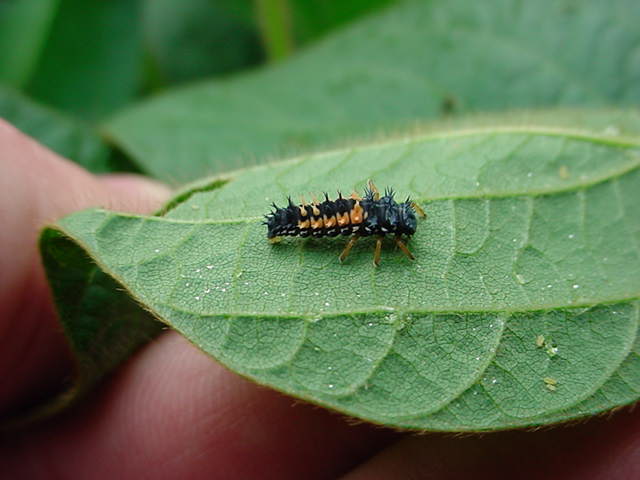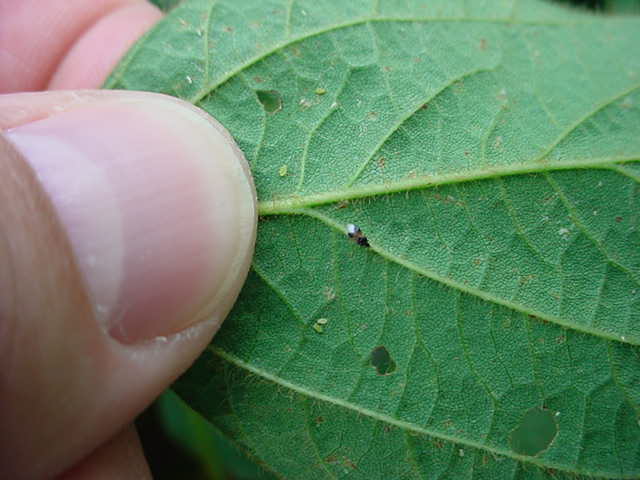Know Your Friends: Beneficial Insects
Above: lady beetles are being released into Purdue greenhouses as a biological control agent. Photo by Purdue University.
Some insects are pests, but not all insects are bad. Overwhelmingly, the majority of insects perform a vital role in the ecosystem. This week, let’s look at a few beneficial insects, as explained in several Purdue Extension publications and websites. These insects may be found benefiting agricultural, vegetable, or fruit crops. So, maybe we can call them friends?
Lady beetles: There are several native lady beetles (a.k.a. ladybugs) that are predators of insect pests. Larvae, which look like little alligators if you use your imagination, feed on aphids, soft-scale insects, mealybugs, spider mites, and other pests. University sources estimate that a lady beetle larva can consume 200-500 aphids during its life stage (until it pupates), and one mature lady beetle can eat 30-50 aphids in one day. Despite the benefits, one species, the Asian lady beetle, also became a nuisance when it began congregating in large numbers on and in buildings during the late fall.
Minute pirate bugs: Minute (as in small, not referring to time) pirate bugs are effective predators of aphids, mites, thrips, and other soft-bodied insects. Both the immature nymphs and adults are predators. Back in the early 2000s, I was helping with Purdue research by scouting soybean fields for the new soybean aphid. I saw minute pirate bugs (and other insects in this article) often. Bob O’Neil, former Purdue University entomologist, estimated that pirate bugs eat up to eight aphids per day. These bugs are not without their bad side, too. They can bite people, but it is mainly an annoyance with no lasting effects.
Hover fly (Syrphid fly) larvae: Purdue entomologist Elizabeth Long recently wrote that hover fly adults are often mistaken for bees, given their black and yellow coloring. “Adult hover flies are important as pollinators, but the larvae are another fierce predator of soft-bodied insects, especially aphids!” she said.
Lacewing larvae: Long also mentioned that lacewing larvae are known as “ant lions,” fierce predators that also crawl along on plants to find soft-bodied insects, like aphids, mealybugs, or eggs to eat. Adults are attractive large-winged insects that do not feed, save a little nectar.
Damsel bugs and Assassin bugs: The latter name should be enough to scare all the bad bugs away. “These insects are also fierce predators and can be seen eating anything from other insects’ eggs to caterpillars, stink bugs, aphids, and more!” said Long. “I’m always amazed to see these insects take down prey that are bigger than they are themselves.” The insects eat other insects by piercing them with their beak- or straw-like mouthparts and then sipping out their body fluids. A warning to people – these insects will try to stab you if handled, so be careful.
Fireflies & relatives: I recently wrote about fireflies, and that they are beneficial insects. Indiana Department of Natural Resources stated that they loosen soil, allowing oxygen, sunlight, and water to penetrate. “They maintain balance by eating impressive quantities of food while in the larval form,” they added. Speaking of firefly larvae, Xerces Society stated, “Because of their large appetites and preference for snails and slugs, fireflies can be highly beneficial in gardens and agricultural settings.”
Ground beetles: Purdue Entomology states that ground beetles are very common and are often mistaken as pests. In truth, these are predators of other potential pests that occur in or on the soil. Ground beetles may not be used as biological control agents by themselves, primarily because they are generalist feeders. However, in concert with other biological and cultural controls, they are valuable, naturally occurring beneficial insects.
I’ve talked a lot in this article about aphids as pests. Purdue Entomology explains that many species of aphids are serious pests of vegetable, fruit, and agronomic crops, as well as ornamental plants. Aphids can become serious pests because they can build up high populations very quickly, and they feed in large colonies. Aphids may cause plant damage in three important ways: they suck out plant juices, they can transmit plant diseases, and they excrete a sugary substance called “honeydew.” Honeydew serves as a base upon which sooty mold can grow. Leaves, and in extreme cases, entire plants, may become covered in this black mold which interferes with photosynthesis.
Learn to recognize these and other beneficial insects. Sometimes, it’s a bug-eat-bug world out there!

Above: Lady beetle larva preying on soybean aphids. Note its alligator-like appearance. Photo by John E. Woodmansee.

Above: Minute pirate bug preying on soybean aphids. Note the tiny white diamond shape on its back where the wings cross. Photo by John E. Woodmansee.
